Rasalhague, designated as Alpha Ophiuchi, is the brightest star in the constellation of Ophiuchus, the celestial serpent-bearer. It is also a binary star.
Key Facts & Summary
- Rasalhague is located at around 48.6 light-years / 14.9 parsecs away from the Sun.
- It is a binary star formed by Alpha Ophiuchi A, and Alpha Ophiuchi B.
- Alpha Ophiuchi A is the primary star, known as Rasalhague.
- Rasalhague is a blue-white giant star of spectral type A5 III.
- The secondary star, Alpha Ophiuchi B, is a main-sequence star still generating energy through the thermonuclear fusion of hydrogen.
- The spectrum of the Alpha Ophiuchi star system indicates an increased level of absorption lines regarding singly-ionized calcium.
- This presence is speculated to be the result of interstellar matter between Earth and the stars, rather than their individualistic properties.
- The stellar system has a combined apparent magnitude of 2.07, with an absolute magnitude of +1.248.
- Rasalhague is more massive than our Sun, having 2.4 solar masses, and 2.6 solar radii.
- The secondary component has only 0.85 solar masses.
- Rasalhague is 25.1 times brighter than our Sun.
- Its surface gravity has been estimated to be at 3.91 cgs.
- Rasalhague is a fast-spinning star, having a rotational velocity of 240 km / 149 mi per second.
- The star system’s radial velocity is +12.6 km / 7.8 mi per second.
- Rasalhague is hotter than our Sun, having surface average temperatures between 7,880 K and 8,050 K.
- The primary star is younger than our Sun, having an estimated age of around 0.77 billion years.
- Since Rasalhague rotates so fast, it has an oblate spheroid shape. Its equatorial bulge is 20% larger than its polar radius.
- Due to its oblateness and speed, the star suffers gravity darkening.
α Ophiuchi
Rasalhague is the brightest star in the constellation of Ophiuchus, the celestial serpent-bearer. Its name comes from the Arabic “ra’s al-hawwa” – which translates to “the head of the serpent collector.”
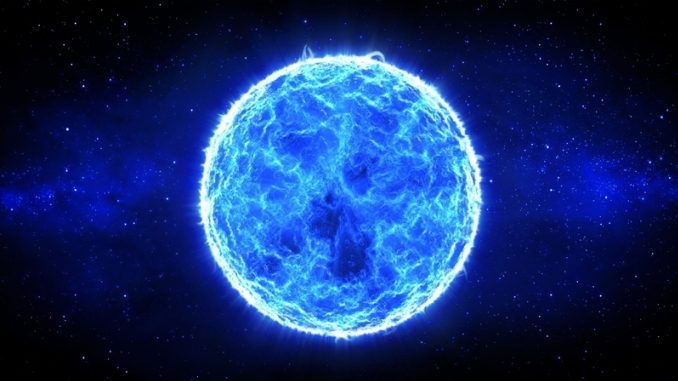
It is named as such due to its position in the Ophiuchus constellation. The IAU officially approved the name Rasalhague for Alpha Ophiuchus in late 2016.
Formation
Rasalhague / Alpha Ophiuchi formed around 0.77 billion years ago from an interstellar medium of gas and dust. Gravity pulled the swirling gas and dust together and resulted in the brightest star of the constellation of Ophiuchus, Rasalhague. It is unclear if both stars in this stellar system formed at the same time.
Distance, Size, and Mass
Rasalhague is located at around 48.6 light-years / 14.9 parsecs away from the Sun. It has an apparent magnitude of 2.07, and thus it is visible to the naked eye.
The primary star, designated as Alpha Ophiuchi A, has around 2.4 solar masses, or 240% of our Sun’s mass, and around 2.6 solar radii, or 260% of our Sun’s radius. Thus, Rasalhague is at least five times bigger than our Sun.
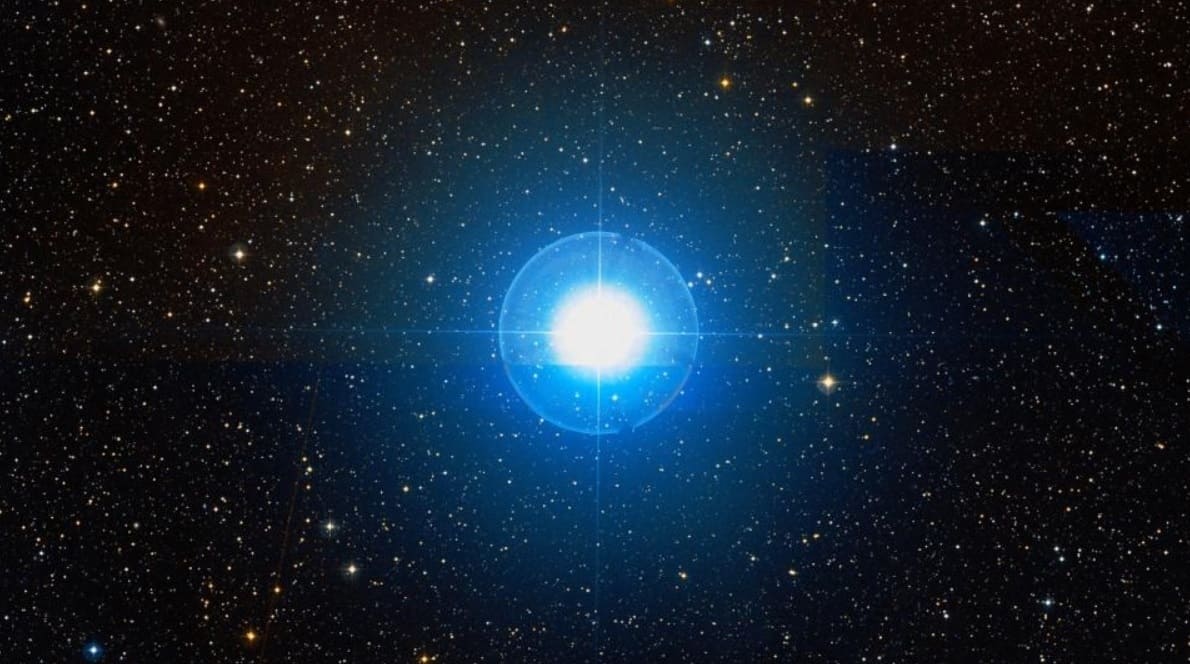
The secondary star, Alpha Ophiuchi B, is less massive than our Sun, having only 0.85 solar masses, or 85% of our Sun’s mass. Its other physical characteristics are currently unknown.
Other Characteristics
Rasalhague is a blue-white giant star of spectral type spectral type A5 III. The secondary star, Alpha Ophiuchi B, is a main-sequence star of spectral type K5-7 V, still generating energy through the thermonuclear fusion of hydrogen.
The spectrum of the Alpha Ophiuchi star system indicates an increased level of absorption lines regarding singly-ionized calcium.
This presence is speculated to be the result of interstellar matter between Earth and the stars, rather than their individualistic properties, however, observations continue.
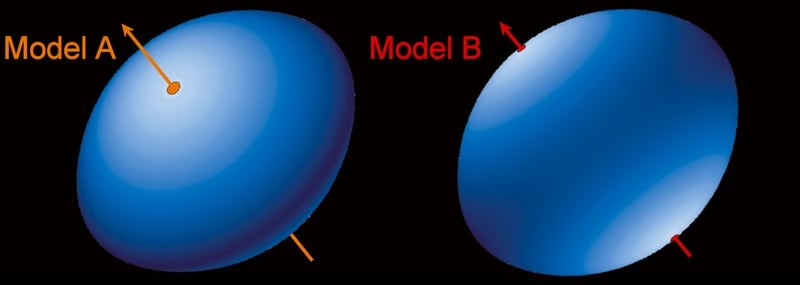
The stellar system has a combined apparent magnitude of 2.07, with an absolute magnitude of +1.248. Rasalhague is 25.1 times brighter than our Sun. Its surface gravity has been estimated to be at 3.91 cgs.
Rasalhague is a fast-spinning star, having a rotational velocity of 240 km / 149 mi per second. The star system’s radial velocity is +12.6 km / 7.8 mi per second.
Since Rasalhague rotates so fast, it has an oblate spheroid shape. Its equatorial bulge is 20% larger than its polar radius. The polar radius is at around 2.388 solar radii, while the equatorial radius is at 2.858 solar radii.
Since Rasalhague spins so fast, and due to its oblate shape, the gravity at its poles is higher than at its equator, an effect known as gravity darkening.
Rasalhague is hotter than our Sun, having surface average temperatures between 7,880 K and 8,050 K. It is thus around 1.3 times hotter than our Sun.
However, not only gravity differs at Rasalhague’s poles and equator, but temperatures as well. At its poles, temperatures reach 9,384 K, while at the equator, it is cooler, reaching 7,569 K.
Stellar System
The two stars forming the Alpha Ophiuchi star system are the bluish-white star Alpha Ophiucus A / Rasalhague and the orange main-sequence star Alpha Ophiuchi B.
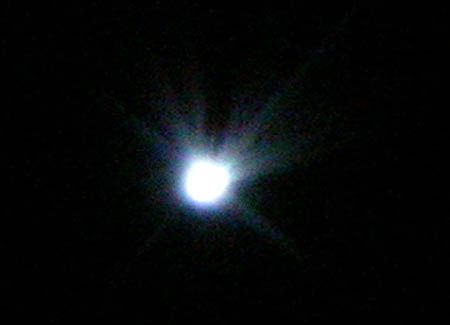
Both stars complete one orbit around each other once every 8.62 years / 3,148.4 days. In April 2012, they reached their closest point to one another, separated by only 50 milliarcseconds.
Location
Rasalhague / Alpha Ophiuchi is located in the equatorial constellation of Ophiuchus, the celestial serpent-bearer. It is near the northern border with the constellation of Hercules. Rasalhague is the brightest star in this constellation, and together with Sabik / Eta Ophiuchi, are the only navigational stars of this constellation.
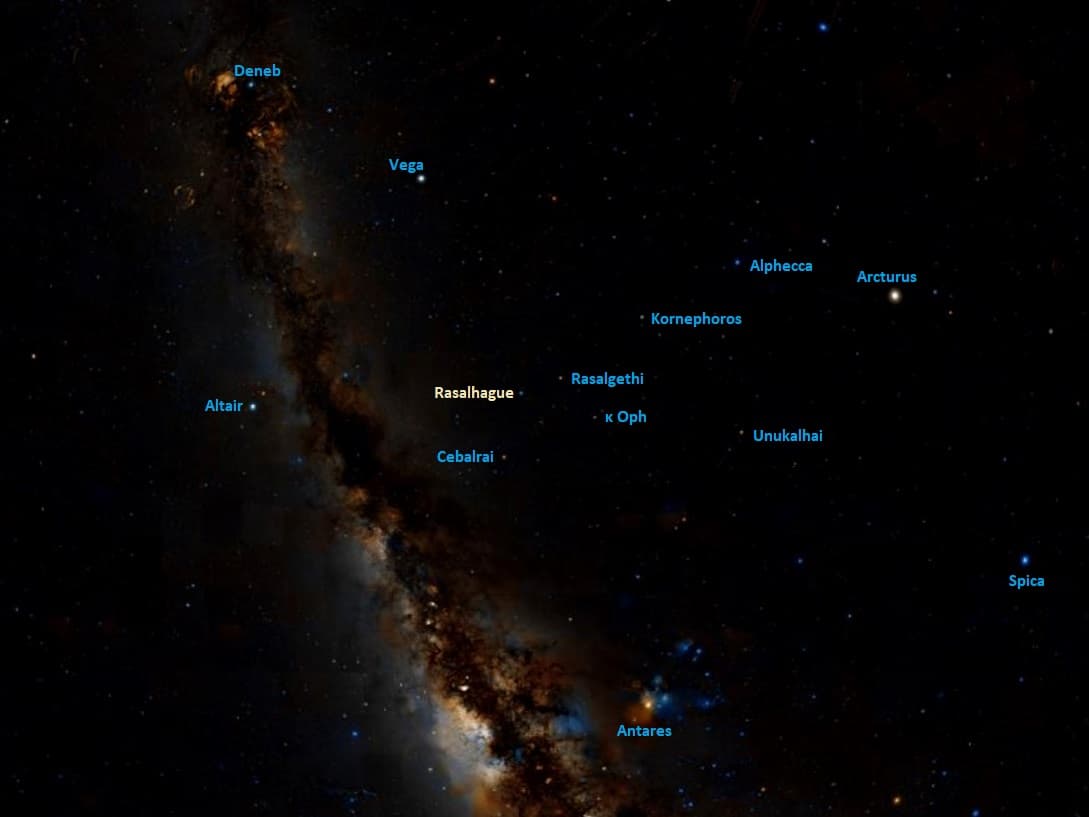
If you want to find Rasalhague, it is located halfway between Vega (constellation of Lyra) and Antares (constellation of Scorpius).
Rasalhague can be used to find several interesting deep-sky objects, such as the barred spiral galaxy NGC 6368, which is located at around 112.5 million light-years away from us.
The constellation of Ophiuchus is also known as Serpentarius, and it represents the mythical Greek healer known as Asclepius. He is usually depicted as holding a giant snake, which is represented by the nearby constellation of Serpens.
Ophiuchus is among the first 48 Greek constellations listed by Claudius Ptolemy in his 2nd century Almagest. Ophiuchus is the 11th largest constellation out of the 88 modern constellations.
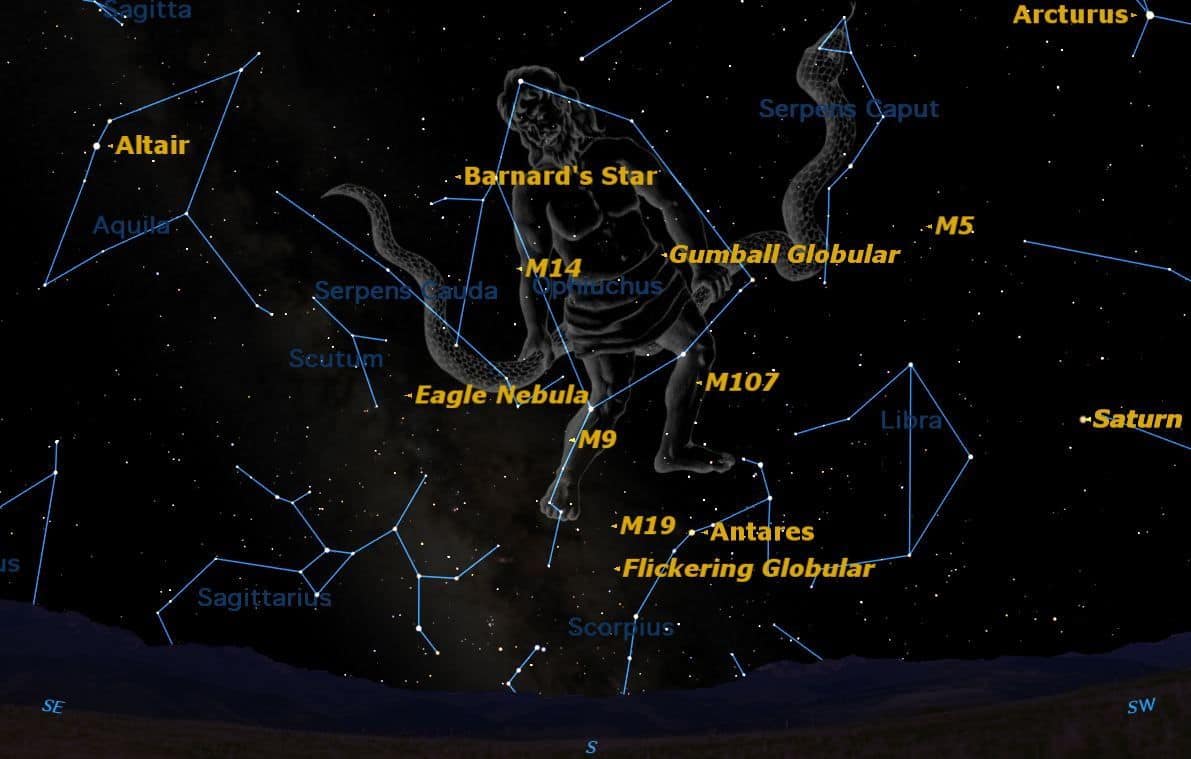
Some interesting Messier objects and deep-sky objects in Ophiuchus are the globular clusters Messier 9, Messier 10, Messier 12, Messier 14, Messier 19, Messier 62, and Messier 107. Their magnitudes vary from 6.42 to 8.85.
Barnard’s Star, one of the closest to Earth, RS Ophiuchi, a recurrent nova, Kepler’s Supernova, Monkowsky’s Butterfly, or the famous Dark Horse Nebula are also located in the constellation of Ophiuchus.
Ophiuchus can be seen from almost anywhere on Earth, and the best time to observe the constellation, Rasalhague, and other bright stars and deep-sky objects, is during the month of July.
The 10 brighest stars in the constellation of Ophiuchus are:
- Rasalhague / Alpha Ophiuchi – magnitude 2.07
- Sabik / Eta Ophiuchi – magnitude 2.43
- Zeta Ophiuchi – magnitude 2.569
- Yed Prior / Delta Ophiuchi – magnitude 2.75
- Cebalrai / Beta Ophiuchi – magnitude 2.75
- Kappa Ophiuchi – magnitude 3.20
- Yed Posterior / Epsilon Ophiuchi – magnitude 3.22
- Theta Ophiuchi – magnitude 3.26
- Nu Ophiuchi – magnitude 3.332
- 72 Ophiuchi – magnitude 3.73
Did you Know?
- Since Rasalhague’s axis of rotation is inclined at 87.7o concerning our line of sight, we see it almost precisely equator-on.
- Rasalhague is part of the 58 bright stars selected for celestial navigation. It is one of the two stars in Ophiuchus which are part of this particular group of stars, the other one being Sabik / Eta Ophiuchus, however, it is fainter.
- Both Rasalhague / Alpha Ophiuchus and Sabik / Eta Ophiuchus are part of another group of 13 stars which are known as the navigational stars of the western hemisphere.
- The other navigational stars of the western hemisphere are Antares (Scorpius constellation), Gienah (Corvus constellation), Nunki (Sagittarius constellation, Alpheratz (Andromeda constellation), Enif and Markab (Pegasus constellation), Altair (Aquila constellation), Alphecca (Corona Borealis constellation), Spica (Virgo constellation), Zubenelgenubi (Libra constellation), and Arcturus (Bootes constellation).
- Rasalhague spins at around 88.5% of its breakup velocity.
Sources:
Image Sources:
- https://www.astronomytrek.com/wp-content/uploads/2017/06/rasalhague-the-star-678x381.jpg
- https://www.star-facts.com/wp-content/uploads/2020/07/Rasalhague.jpg?189db0&189db0
- https://upload.wikimedia.org/wikipedia/commons/thumb/b/be/Eso0316c.tif/lossy-page1-800px-Eso0316c.tif.jpg
- https://i.pinimg.com/originals/5f/3e/49/5f3e493724fd9c3fc0a88b36f71f9a91.jpg
- https://www.star-facts.com/wp-content/uploads/2020/07/Rasalhague-location.jpg?189db0&189db0
- https://cdn.mos.cms.futurecdn.net/NV6kwnXYNR6w9GHZspGnNL-1200-80.jpg
